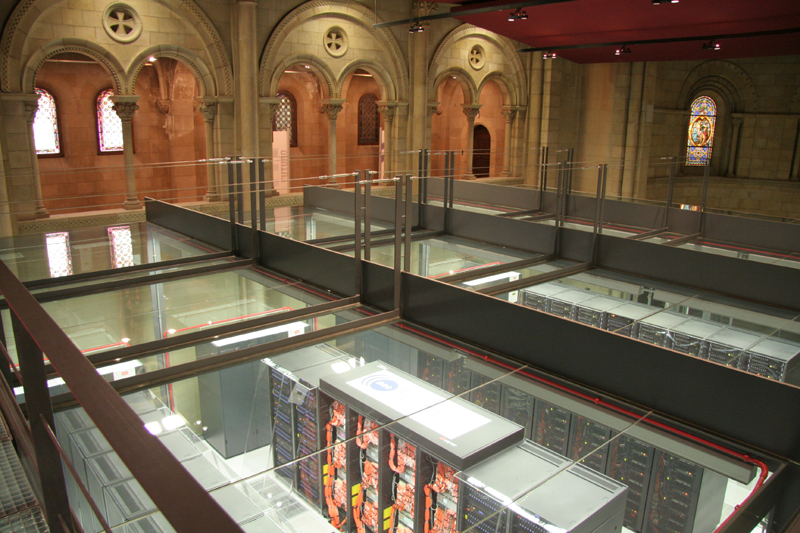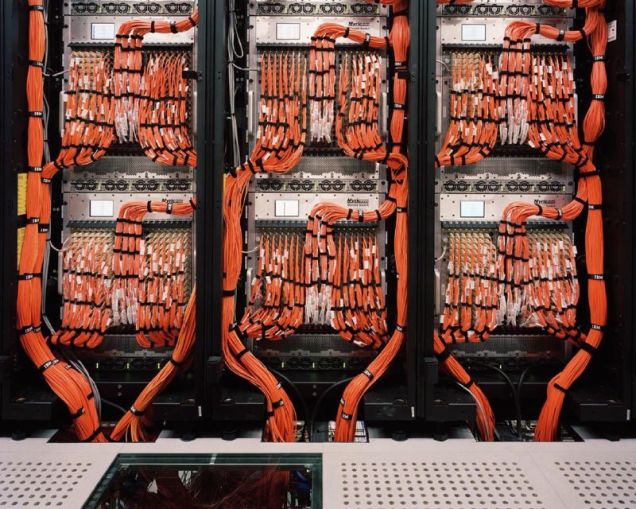 11.16.50.png)
What used to be a divine place of worship is now the home of the Barcelona Supercomputing Center. The Torre Girona church houses what could possibly be the most beautiful computer in the world if computers can actually be beautiful, and it fills the expansive main hall with banks of futuristic computer equipment within a glass box.
Marenostrum, as it is named, has been housed in this former church since 2005. It is one of the most powerful supercomputers in Europe that was instrumental in developing modern microchip technology. The giant machine is used to calculate the massively complex calculations involved in such fields of research as human genome mapping, astrophysics, and weather prediction. Physically the computer consists of a number of black computing racks that are all encased in a giant glass box, which itself sits in the romantically-styled main hall of Torre Girona.


Rebuilt after the Spanish Civil War, the Torre Girona is a 19th-century church that sits on the campus of the Polytechnic University of Catalonia. The space was actually in use as a Catholic church until at least until 1960 but was since deconsecrated and used for more functional purposes until finally being inhabited in full by the supercomputer and its attendant offices.
MareNostrum is one of the most powerful supercomputers in Europe. To put MareNostrum’s  original calculating capacity into terms a typical PC owner can appreciate; it has 10,240 IBM 2.3 GHz processors and 20 Terabytes of main memory. That doesn’t, however, mean that – if you went out and bought 10,240 PCs and joined them together, you would have the power of a MareNostrum. Those 10,240 PCs would, putting it very simply, work rather like a production line producing, for example, a car silencer – the first person would weld a seam on a rolled form, the second would insert one end plate and weld it in, the third would insert a pipe and so on; one job would follow on another, so nothing would be completed until the final person/processor in the chain had finished its allocated job.
original calculating capacity into terms a typical PC owner can appreciate; it has 10,240 IBM 2.3 GHz processors and 20 Terabytes of main memory. That doesn’t, however, mean that – if you went out and bought 10,240 PCs and joined them together, you would have the power of a MareNostrum. Those 10,240 PCs would, putting it very simply, work rather like a production line producing, for example, a car silencer – the first person would weld a seam on a rolled form, the second would insert one end plate and weld it in, the third would insert a pipe and so on; one job would follow on another, so nothing would be completed until the final person/processor in the chain had finished its allocated job.
MareNostrum’s processors don’t work like that! The architecture of this super computer is such that all those 10240 2.3 GHz processors work together, sharing the work of producing the end product, rather than passing each phase of the process on, the result is a capacity to perform a staggering 94.21 trillion operations per second!
 11.17.05.png)
It has since been upgraded. Now MareNostrum has a peak performance of 1,1 Petaflops, with 48,896 Intel Sandy Bridge processors in 3,056 nodes, and 84 Xeon Phi 5110P in 42 nodes, with more than 104.6 TB of main memory and 2 PB of GPFS disk storage. God knows what that is in everyday English but for those who understand computers, you might find it interesting!
MareNostrum may not be the most powerful computer in the world any longer, but it will likely remain the most visually appealing for many years to come.
There are two ways to visit the supercomputer: either in pre-booked organised groups or virtually.
Here are the links for more information.
Physical Tour
Virtual Tour